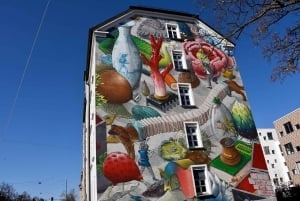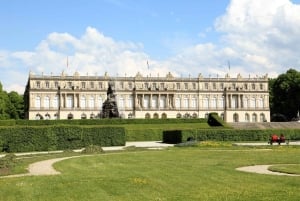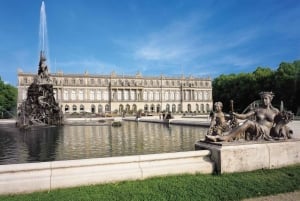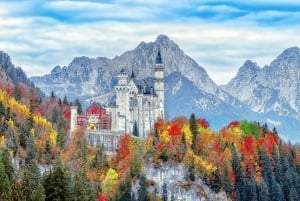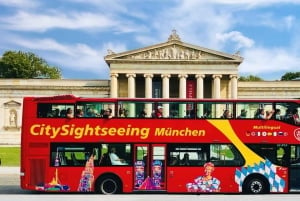Traditions
A coat of arms, or so called armorial achievement or armorial bearings, is a design belonging to a particular person, or, as it is in the case with Munich, to a particular town.

The coat of arms of Munich shows a monk wearing a black cowl and holding a red book. A similar form does exist since the 13th century. The German name of Munich means "of Monks". Therefore it is very self-explaining, that a monk represents the city of Munich. Since the 19th century the monk was often depicted more youthful and became known as the "Münchner Kindl" (Munich child).
Coat of arms of Bavaria
 The coat of arms of the state of Bavaria consists of different lions, which basically symbolize administrative regions in Bavaria. The white and blue heart shield was used by the House of Wittelsbach and today stands for Bavaria as a whole. The nation´s crown symbolizes sovereignty of the people after the dropping down of the royal crown.
The coat of arms of the state of Bavaria consists of different lions, which basically symbolize administrative regions in Bavaria. The white and blue heart shield was used by the House of Wittelsbach and today stands for Bavaria as a whole. The nation´s crown symbolizes sovereignty of the people after the dropping down of the royal crown.
Yodeling
Yodeling is a form of singing that was probably developed in the Alpine regions and was originally used as a form of communication between mountain peaks. Today it became part of traditional folk music. In the Alpine region around Munich you can find some places that work very well for yodeling, even with an echo.
"Schuhplatteln" - Bavarian Clog Dance
This traditional folk dance was originally used by Bavarian men, who intended to impress young and marriageable ladies. The Schuhplattler is performed in a ¾ time and consists of a combination of different jumps and movements. The dancers will strike their thighs, knees and soles of their feet and will also stamp with their feet to the rhythm of the music. Today this dance is only used as a traditional performance shown by Folklore clubs to keep the tradition alive.
Beer
Munich would not be Bavarian without its famous beer breweries such as Augustiner Braeu, Hofbraeu, Hacker-Pschorr, Loewenbraeu, Paulaner and Spaten-Franziskaner. Any kind of beer brewed in Germany has to comply with the German purity law, which specifies that only water, malt, hops yeast can be used to create this, probably best beer in the world.
Munich is especially known for different kinds of beer: The "Weißbier" (wheat beer) for example is a Bavarian speciality. The most popular beer is "Helles". It is of a translucent golden colour and was introduced in 1895. Besides the Helles, there is still the "Dunkles" (Munich dark beer), which was the original beer and gets its dark colour from burnt malt.
"Starkbier" is also available in Munich, especially during the Lenten (strong beer season) in Spring. It contains about 6-9 % alcohol.
Traditionally, beer in is served in big mug ("Maß"), which holds one liter.
Culinary specialities
White saus ages ("Weisswürste") are served traditionally with sweet mustard and freshly baked pretzels ("Brez´n") and have to be eaten only before 12:00 o´clock. This tradition dates back to the time before refrigerators were invented. In most Bavarian Restaurants white sausages will still not be served after 12:00 noon. Also a very famous dish is grilled chicken, which the Bavarian people simply name "Hend´l". When enjoying a nice and cold beer at one of the beergardens in Munich, you should not miss to taste a "Steckerlfish", a local fish speared on a wooden stick, crispy smoked and grilled on charcoal. A main dish served as lunch or dinner is, unmistakably the "Schweinsbraten", a pot roasted pork with dumplings made from potatoes and/or white bread.
ages ("Weisswürste") are served traditionally with sweet mustard and freshly baked pretzels ("Brez´n") and have to be eaten only before 12:00 o´clock. This tradition dates back to the time before refrigerators were invented. In most Bavarian Restaurants white sausages will still not be served after 12:00 noon. Also a very famous dish is grilled chicken, which the Bavarian people simply name "Hend´l". When enjoying a nice and cold beer at one of the beergardens in Munich, you should not miss to taste a "Steckerlfish", a local fish speared on a wooden stick, crispy smoked and grilled on charcoal. A main dish served as lunch or dinner is, unmistakably the "Schweinsbraten", a pot roasted pork with dumplings made from potatoes and/or white bread.


